The modern-day laundry process has come a long way from the days when hand scrubbing and using washboards and clothes wringers made it much more of a time-consuming, physically demanding task.
But let’s face it, even with the conveniences of today’s smart, high-tech appliances and more efficient laundry cleaning products, doing the laundry is still one of our least favourite home chores.
It doesn’t help when common laundry mistakes cause problems that can damage your clothing, add extra time to the laundry process, and even make your home less safe.
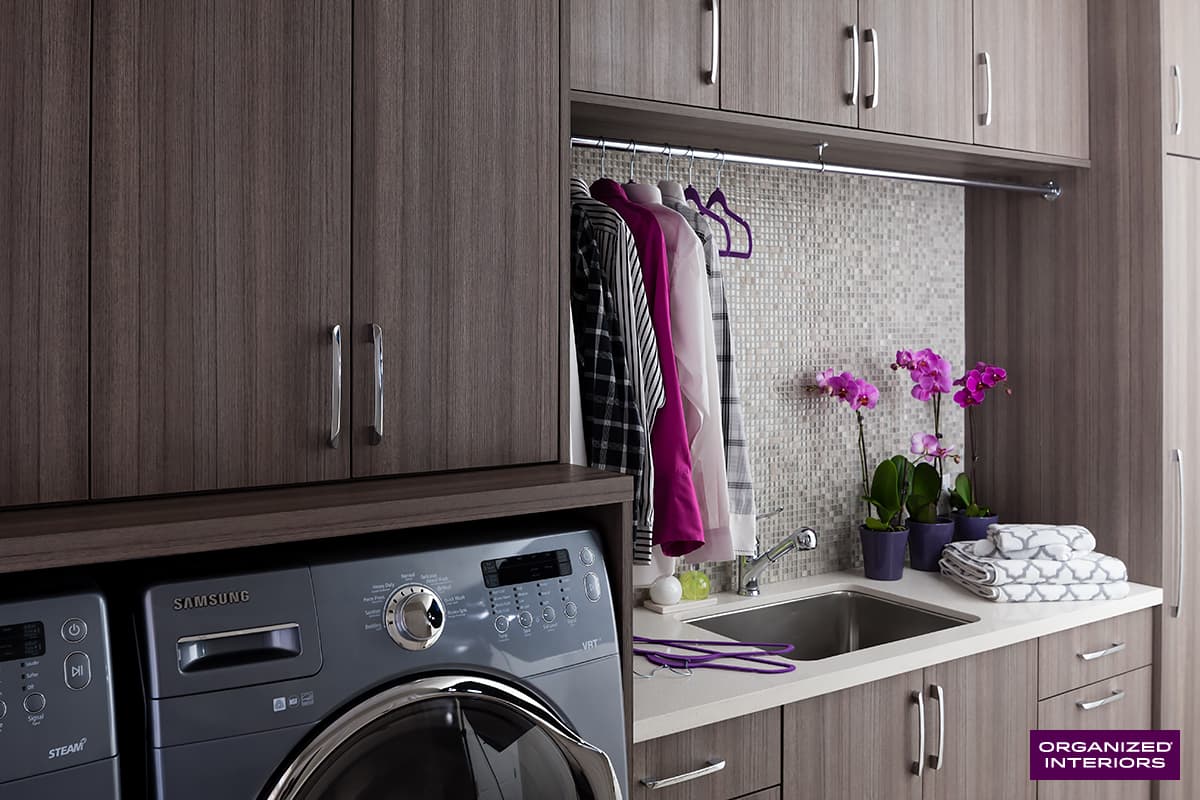
Avoid these common laundry mistakes
The average time to wash and dry a load of clothes is about 90-100 minutes (using normal wash and dry cycles).
That doesn’t even include the time it takes to collect and sort dirty clothes, nor the time required to re-sort, iron, fold, and put away your laundered clothing. The average family does approximately seven loads of laundry per week, which works out to over 400 laundry loads annually.
It’s no wonder that doing the laundry is the most time-consuming household task after cooking!
So how can you streamline the process and avoid making the types of laundry mistakes that can waste your time and shorten the life of both your clothing and laundry appliances?
We’ve chosen some of the most common bad laundry habits and explain how to go about doing your laundry the right way.
1. Using too much detergent
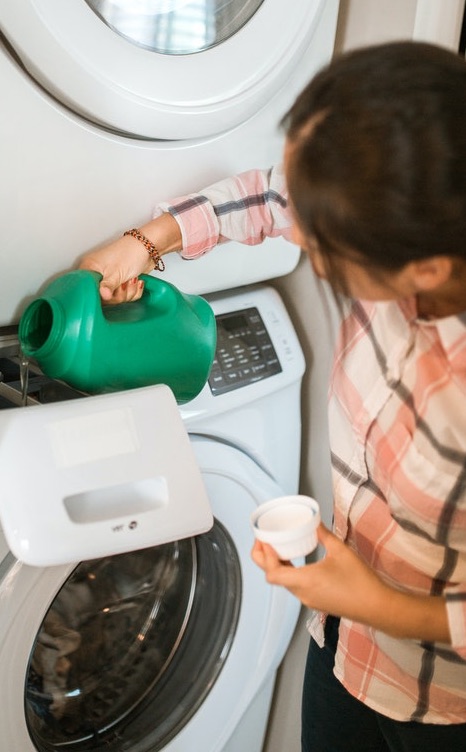
Photo by Rodnae Productions from Pexels
Overusing detergent is one of the most common laundry mistakes. Doing so doesn’t get your clothes any cleaner, however – it only creates problems.
Adding too much detergent to a washer load (whether it’s with a liquid detergent dispenser or using pods) generates more suds than you need.
That makes your clothes harder to rinse and can leave detergent residue or excess dirt and bacteria on them. A washer that can’t drain as efficiently because it has too many suds also has to work harder and can harbour more bacteria.
Using a regular laundry detergent in a high-efficiency washer that should be using a high-efficiency detergent (which you use less of compared to traditional detergents) will generate too many suds as well.
The washer manufacturer’s recommendation for how much detergent to use shouldn’t necessarily be taken as gospel, either.
Try cutting back your liquid detergent use per washer load to three-quarters of what is recommended and see if you’re satisfied with how your clothes are coming out at the end of the wash cycle.
2. Not regularly cleaning the dryer lint trap and vent
Dryer fires caused by lint buildup cause hundreds of fires across Canada every year. Consumer Reports says that dryer fires are much more likely to be caused by lint buildup that is ignored than electrical malfunctions.
Another reason to avoid having significant lint buildup in the dryer and its ductwork and vents is that it extends your drying times. That uses up more energy because the appliance can’t run as efficiently as it should, makes doing the laundry take longer, and shortens the life of a dryer.
To correct one of the most common laundry mistakes and avoid any lint-related issues, be proactive and follow these guidelines:
- clean your lint trap after every load
- check your exterior dryer vent for lint buildup a couple of times per year
- occasionally check behind and underneath your dryer for loose lint
- disconnect your dryer vent hose and vacuum inside of it twice a year
- have your dryer ductwork cleaned every couple of years by a professional
3. Having a laundry room that lacks functionality
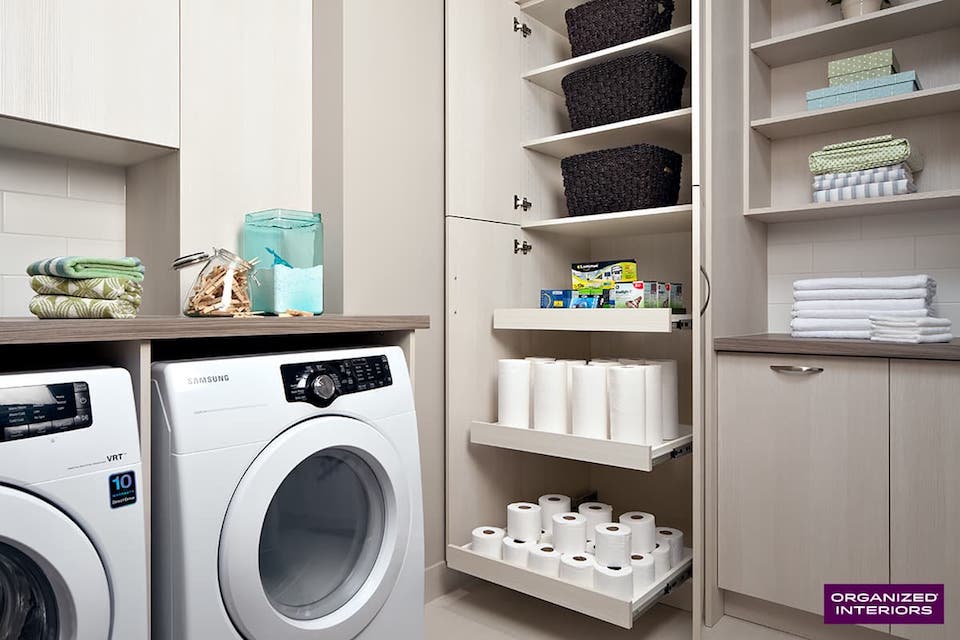
Remodel your laundry room for an optimal level of functionality by adding custom cabinetry with pullouts.
Considering how much time you spend doing laundry every year, it’s a wise investment to upgrade your laundry room to improve its functionality.
There’s a lot you can do with the room to give it more usefulness, which helps to streamline the laundry process. Here are a few laundry room upgrade ideas:
- maximize the room’s storage space with custom cabinetry that holds all of your laundry supplies
- add built-in laundry hampers to keep the room more organized and cut down on the time it takes to sort dirty clothes
- create more usable workspace for folding and sorting laundry with new countertops
- install convenient laundry helpers like a pullout ironing board, pullout drying drawers, and retractable valet rods
- add or upgrade your laundry sink and faucet
- if your laundry room has the space, install an island that provides an extra work surface and additional storage room
4. Treating stains incorrectly
Stained clothing needs to be dealt with sooner rather than later in order to avoid having a stain set in to the point where eliminating it becomes unnecessarily difficult.
To treat clothing stains effectively, first check the clothing’s label for any guidelines for dealing with stains. There are a few variables involved with treating stains, including what type of clothing you’re dealing with and the liquid or item that caused the stain itself.
A laundry stain remover spray or regular detergent can be used to treat the stain and a number of stain removal remedies using household items can also work.
If a stain removal product isn’t readily available, try submerging the stained part of the clothing in cold water or gently blot the stain with water to keep it from drying before you can deal with it further.
Another tip is to gently dab the stain and avoid scrubbing it too vigorously, which can cause the stain to spread and wear down the fabric.
5. Doing partial laundry loads or loads that are too big
It’s not energy-efficient to only do partial loads of laundry, even with a washing machine that has a setting that lets you adjust the washer’s water level.
Washing machines account for approximately a fifth of the water usage in the average home. A partial washer load with a lower water level will use up almost as much electricity as a full load, too.
Another of the laundry mistakes we make is overstuffing the washer and dryer. Hey, we’ve all had items overflowing from the top of a washer or had to use a little extra muscle to shut that dryer door because the drum was so full.
Here’s exactly why shouldn’t overload your laundry appliances:
- a beyond-capacity load of clothes in a washer will be packed too tightly together and won’t get evenly cleaned
- an overloaded dryer won’t dry all of your things as efficiently
- laundry appliances have weight capacities and you can wear them out prematurely with excessively heavy loads
6. Using dryer sheets instead of dryer balls
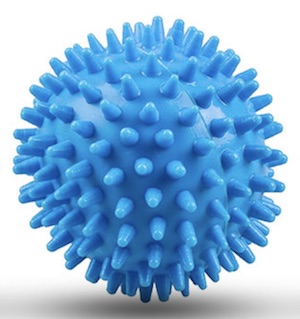 Dryer sheets will get your clothes smelling more fragrant, but that highlights one of their negatives – they’re loaded with toxic chemicals that produce that pleasant smell and help them do their other jobs of softening clothes and reducing static.
Dryer sheets will get your clothes smelling more fragrant, but that highlights one of their negatives – they’re loaded with toxic chemicals that produce that pleasant smell and help them do their other jobs of softening clothes and reducing static.
In addition to the fact that they’re not exactly great for your health, dryer sheets are also less eco-friendly compared to dryer balls.
Most types of dryer sheets are used once and thrown away, their chemicals get released into the atmosphere via your dryer vent, and they don’t separate your clothes as well as dryer balls, which extends drying times.
Dryer balls are a little more cost-effective since they’re reusable and contain little or no chemicals. Another of the advantages dryer balls have over dryer sheets is that they produce less lint that sticks to clothes and ends up in the dryer’s lint screen. Over time, the dryer sheets’ coating tends to leave a thin residue that builds up on the lint trap as well.
7. Not delegating laundry duties
Running a household is hard work and every contribution to keep the home functioning smoothly helps. Therefore, don’t hesitate to delegate laundry duties to (literally) lighten your load.
If your kids are old enough to handle using a washer and dryer, there’s no reason they shouldn’t be helping out once in awhile with the home’s laundry tasks.
Getting them involved in weekly laundry duties teaches kids how to be more responsible. And their dirty clothes are contributing to the workload, so it makes even more sense for them to bear some of the work burden.
Even young kids who aren’t old enough to use laundry appliances yet are capable of putting their clean clothes away in their room when given the proper directions.
8. Using the wrong washer and dryer settings
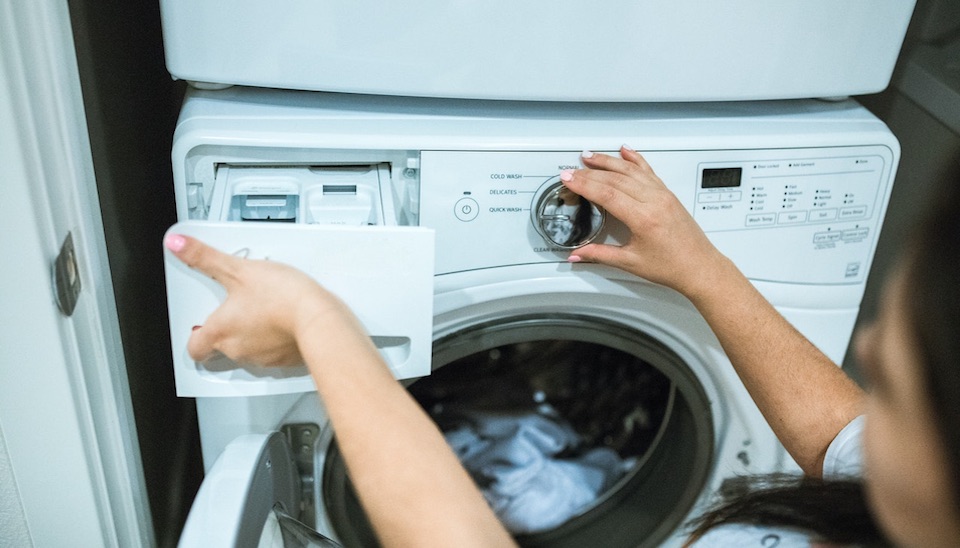
Take the time to full understand which appliance settings will work most efficiently. (Photo by Rodnae Productions from Pexels)
Perhaps you have recently bought a new washer and/or dryer. If you used the same laundry appliances for years, it’s easy to just apply the same methodology you’re familiar with to your new machines. This is one of the types of laundry mistakes that is easy to avoid.
Chances are, you’ll need to make some sort of adjustment with the new appliances. Modern washers and dryers offer more settings and washing options than older models.
If you’re the type who never looks at the instruction manual of the products you buy, you’ll want to take a few minutes to read the user guides for your new washer and dryer.
There is sure to be at least one piece of useful information in them you’ll find useful, whether it’s something related to their maintenance or a simple operating tip you’ve been ignoring.
One more tip is to use less hot water for your wash cycles unless you’re cleaning items that typically harbour more bacteria like bath, hand, and dish towels, underwear, and sweaty clothing.
Cold water will do the job fine in most cases and is easier on your fabrics. It’s cheaper to use as well, since heating the water accounts for as much as 90% of a washer’s energy consumption.
9. Using outdated laundry appliances
Using laundry appliances you bought 20+ years ago will naturally consume more electricity compared to a newer washer or dryer model that is designated with the familiar Energy Star logo.
Newer washers will also use less water than old washers and front-loading washers operate more efficiently than top-loading washers. High-efficiency washers that are very energy-efficient and use less detergent are becoming more popular with homeowners.
One of the most attractive reasons to upgrade your laundry appliances is the wide variety of convenient features they offer, especially smart washers and dryers.
Higher-end modern laundry appliances include helpful features like:
- moisture sensors to prevent overdrying
- AI technology to determine the best settings for washing or drying clothes
- load capacity sensors
- notifications that can be sent to your smartphone to alert you when a wash or dry cycle is done
- a powerful steam cycle to eliminate common household allergens
10. Leaving buttons buttoned and zippers unzipped
One of the more common laundry mistakes that can damage your shirts is to leave them buttoned up when they’re being washed or dried.
If shirts are left buttoned up, all of that tumbling around inside the appliances puts stress on the buttons and buttonholes that can cause threads to loosen and buttons to fall off.
Leaving the zippers on pants or other types of clothing unzipped is another mistake to avoid. The metal teeth of a zipper can easily catch on another piece of clothing and cause damage, particularly with delicate fabrics.
11. Ignoring the decor of your laundry room

A few hundred hours can be spent in the laundry room over the course of a year. Why not make it look nicer?
We’ve covered the benefits of improving your laundry room’s functionality. Why not pay some attention to upgrading the room’s appearance, too?
“Stylish décor” isn’t something many of us associate with a laundry room – but why not? There’s no reason to pay any less attention to a laundry room’s look than you would to any other room in your home.
When you consider just how much time you’ll spend in the laundry room over the course of a year, that should be even more incentive to make it look and feel more inviting.
To freshen up the room’s décor, give the walls and ceiling a fresh coat of paint or add wallpaper with a high humidity tolerance. Brighter lighting, new flooring, a rug, some wall art, and some plants (if the room gets enough sunlight) will get you that much closer to creating a comfortable laundry space.
High-quality custom cabinetry will allow you to choose stylish decorative hardware and appealing finishes that complete your décor upgrade.
12. Not cleaning your washing machine
It might not seem like it needs it, but that appliance that gets your clothes clean occasionally needs to be cleaned itself. Not all of the bacteria from the loads of dirty clothes and linens that you wash just disappears with the drained laundry water.
If you have an old washing machine or wash in cold water 100% of the time, your appliance will likely be even more susceptible to bacteria buildup. A telltale sign that your washer needs a cleaning is that it will have an unpleasant odour that is being caused by a buildup of mould and mildew.
To eliminate washing machine bacteria (as well as the buildup from dirt and detergent), it’s a good idea to run a cleaning cycle with no clothes in the machine using hot water and bleach (or a bleach alternative) on a monthly basis.
Samsung recommends keeping a washing machine’s door and detergent drawer open after using it to prevent mould and mildew from forming.
13. Washing jeans the wrong way
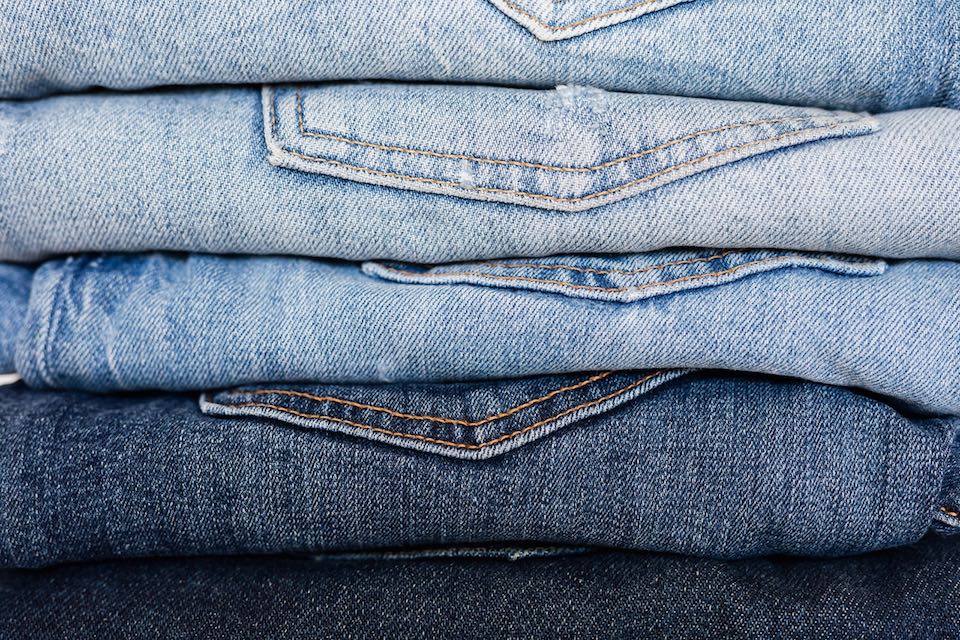
Photo by Karolina Grabowska from Pexels
Denim may be one of the most rugged types of fabrics we wear, but washing and drying jeans the wrong way is one of the laundry mistakes that can cause your favourite pair of pants to fall apart prematurely.
People commonly wash their jeans using their washer’s heavy-duty setting because they think denim requires it. Unless the care label on the jeans says so, however, this is unnecessary and only putting more stress on the pants. Jeans don’t require anything higher than a medium or low setting for the dryer, either.
How often you wash your jeans is a personal choice. As long as a pair of jeans smells fine and looks presentable, that’s good enough for a lot of people. If you prefer to be a little more proactive with keeping your jeans clean, Good Housekeeping magazine’s product testers recommend washing jeans every three or four wears.
A jean washing tip you might not know is that they should always be turned inside out when being washed and dried. It’s gentler on the outer fibres of the pants and slows down the fading process.
Transform your laundry room
These best practices can correct some of the most common laundry mistakes we make and help to save you some time and frustration when doing your laundry.
If it’s time for your outdated laundry room to get some special attention to make it more functional and modern-looking, Organized Interiors is the design professional to trust.
Schedule a complimentary design consultation with us to begin planning your laundry room transformation.
Please share this post if you found it useful.
